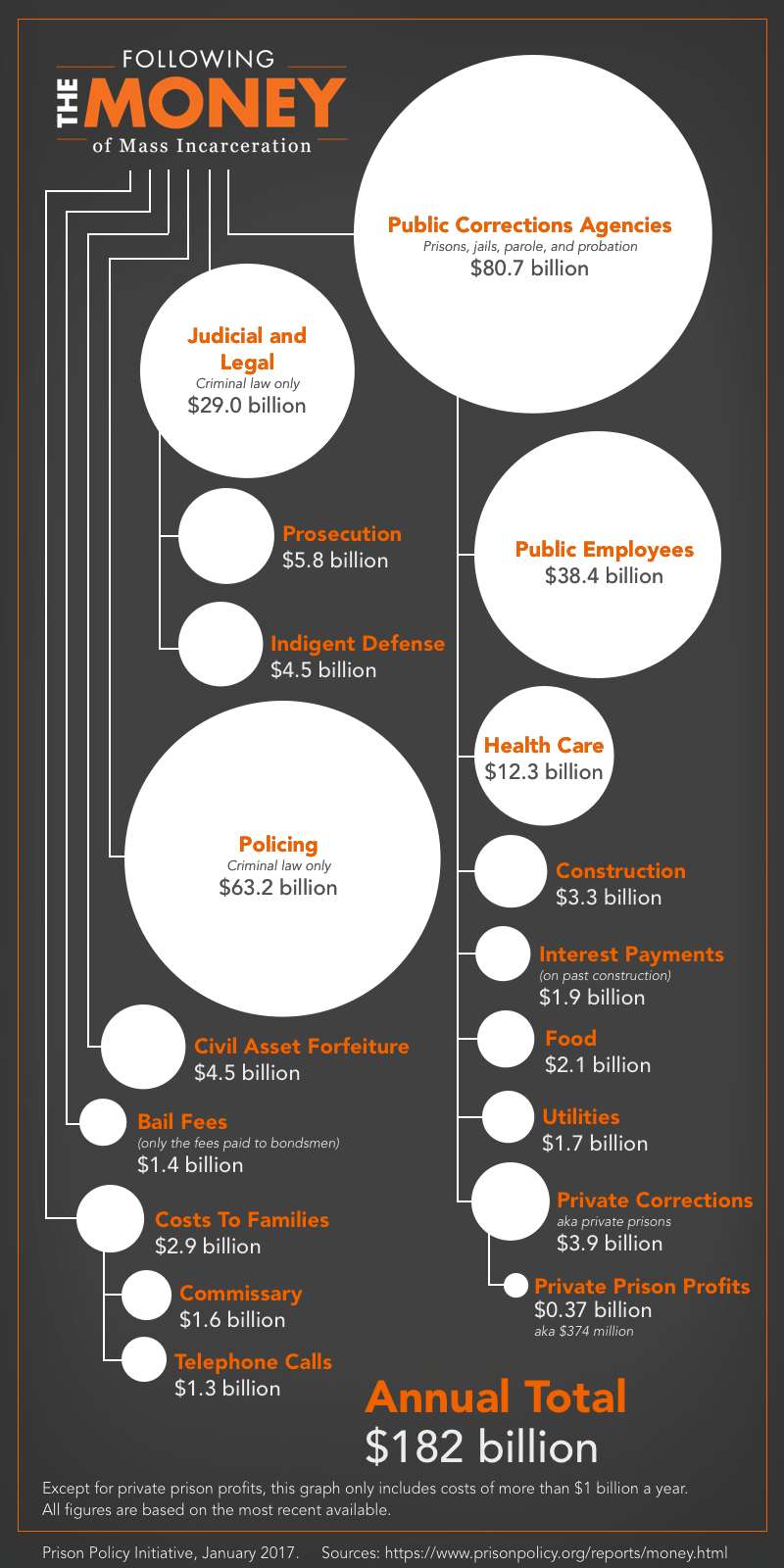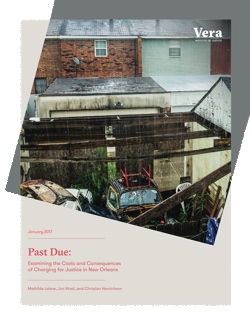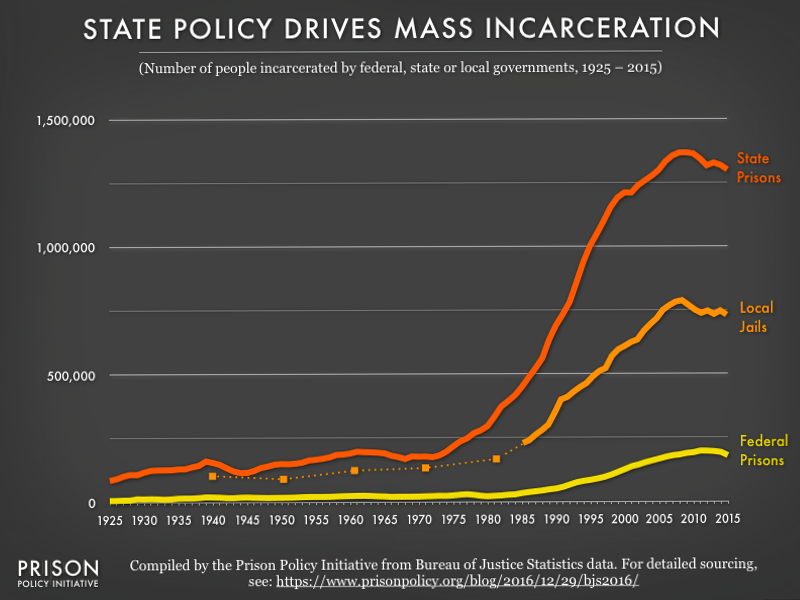Welcome Lucius Couloute, our new Policy & Communications Associate!
by Wendy Sawyer,
January 31, 2017
 Please welcome our new Policy & Communications Associate, Lucius Couloute.
Please welcome our new Policy & Communications Associate, Lucius Couloute.
Lucius is currently a doctoral student at the University of Massachusetts at Amherst in the Sociology department; previously, he earned his Bachelor’s degree from UMass in Economics. His dissertation examines the role of race and insecure employment experiences during prisoner reentry. Lucius is from Hartford, where he also serves as a member of the Greater Hartford Reentry Council.
Welcome, Lucius!
In a first-of-its-kind report, the Prison Policy Initiative aggregates economic data to offer a big picture view of who pays for and who benefits from mass incarceration.
January 25, 2017
In a first-of-its-kind report, the Prison Policy Initiative aggregates economic data to offer a big picture view of who pays for and who benefits from mass incarceration.

The report, Following the Money of Mass Incarceration, and infographic are a first step toward better understanding who benefits from mass incarceration and who might be resistant to reform.
In the report, the Prison Policy Initiative:
- provides the significant costs of our globally unprecedented system of mass incarceration and over-criminalization,
- gives the relative importance of the various parts,
- highlights some of the under-discussed yet costly parts of the system, and then
- shares all of its sources so that journalists and advocates can build upon its work.
Following the Money of Mass Incarceration establishes that:
- Almost half of the money spent on running the correctional system goes to paying staff. This group is an influential lobby that sometimes prevents reform and whose influence is often protected even when prison populations drop.
- Private companies that supply goods to the prison commissary or provide telephone service for correctional facilities bring in almost as much money ($2.9 billion) as governments pay private companies ($3.9 billion) to operate private prisons.
- Commissary vendors that sell goods to incarcerated people — who rely largely on money sent by loved ones — is itself a large industry that brings in $1.6 billion a year.
“Following the Money of Mass Incarceration finds that mass incarceration and over-criminalization are deeply embedded in our economy,” said report co-author and Prison Policy Initiative Executive Director Peter Wagner. “Changing our nation’s criminal justice priorities is going to require challenging a lot of entrenched but often hidden interests.”
The report is available at: https://www.prisonpolicy.org/reports/money.html.
The first ever national survey of in-state jail phone rates finds some jails charge more than $1.50 a minute.
by Aleks Kajstura,
January 19, 2017
Two recent submissions to the FCC shed new light on the high cost of in-state phone calls from jails. While the campaign to make phone calls from prison and jail more affordable for family and friends of incarcerated people has made significant progress, the new filings underscore how private companies continue to avoid regulation while charging unconscionable rates.
These submissions present new research which reveals that some in-state calls cost over $1.50 a minute, and finds pricing structures that “bear a remarkable similarity” to practices prohibited by the FCC.
In order to “highlight the current ICS [Inmate Calling Service] landscape” for the FCC, Lee Petro, counsel for the Wright Petitioners, and the Prison Policy Initiative (thanks to members of our Young Professionals Network) conducted a survey of jails served by the major ICS providers.
The most significant discovery made from reviewing the current pricing policies of the ICS providers was that several ICS providers have imposed a rate structure for intrastate ICS calls that bear a remarkable similarity to the now-prohibited “connection fee” which was prohibited in the 2015 Second Report and Order, and memorialized in Section 64.6080 of the Commission’s rules.
These pricing schemes have resulted in 15 minute calls that would cost $24.95 from the Arkansas County Jail via Securus and $17.77 from the Douglas County jail in Oregon via Global Tel*Link.
You can find the summary of the Comments submission findings in the Ex-Parte submission, and the rates for all of the jails surveyed in exhibits B and C of the Comments submission (starting on page 82), and exhibits A and D in an updated filing reflecting Legacy’s correction of their advertised rates.
Private companies amassing monopoly contracts, creating potential to rake in $172 million from friends and family sending money to incarcerated loved ones.
by Stephen Raher,
January 18, 2017
As with many areas of government, prisons and jails are increasingly shifting costs to those who can least afford it: incarcerated people and their families. In correctional facilities, this often takes the form of copays for medical care, forcing incarcerated people to purchase clothing or hygiene items, and cutting food service in favor of for-profit “canteens.” Because most incarcerated people lack money to cover such expenses, this means that family members must frequently transfer money to “inmate trust accounts.”
Historically, families could send money to an incarcerated relative’s account by simply mailing a money order. But private companies saw an opportunity to use these accounts as a potential source of profits. For an upcoming report, we set out to find the answer to a seemingly straightforward question: How much do these companies earn off of money transfers? It’s hard to say, because there is no publicly-available data that gives a complete picture; however, certain limited data can be used to arrive at a rough estimate.
Four states have published data on the volume of money transfers in their state prison systems. This data covers Nevada, Ohio, and Wyoming (all calendar year 2011), and Pennsylvania (2014). Dividing the total amount of transferred funds by the states’ respective prison populations yields average annual transfers of $737 per incarcerated person. Multiplying this average amount by the total population of all state prisons (in 2016) would yield annual transfers of $995 million.
But the amount of money transferred doesn’t tell us how much money the companies make on the process. The difficulty in estimating fee revenue comes from the fact that the amount of the transaction fee varies among jurisdictions. In addition, some jurisdictions may still allow family members to send funds for no fee through the mail; while other states may charge a fee for payments by mail, or simply prohibit no-fee options.
Direct evidence of fee revenue is available for JPay, Inc., one of the largest payment processors for prisons and jails. JPay is currently a subsidiary of telecommunications firm Securus Technologies, which is owned by private equity firm Abry Partners. In an April 2015 presentation to potential lenders, Securus stated that in 2014, JPay made $53 million in fees (page 49) on transfers of $525 million (page 38). This suggests an average fee of 10% (i.e., $53 million ÷ $525 million = .10).
If, as stated above, the total amount of state-prison money transfers is $995 million per year, then with fees at 10%, payment processors could potentially make up to $99 million in fees, assuming every prison system in the country privatized money transfer services and eliminated no-fee options. This aligns precisely with the Securus/JPay investor presentation, which estimates the total market for money transfers in state prisons to be worth $99.2 million in corporate revenue (page 45).
My discussion so far has not mentioned county jails and the federal prison system, because information about money transfers in these settings is even more difficult to find. In fact, some of the only information available at this time is Securus’s estimate of the total potential market. In 2015, Securus told potential investors that the total potential fee revenue from county jails and federal prisons was $58 million and $15 million respectively.
Notably, the most lucrative money transfer market may not even involve correctional facilities. Among the proliferation of user fees being imposed on the poor are fees levied on people serving time on probation or parole. Processing those payments means lots of money for companies like Securus/JPay. In fact, Securus believes that it if it obtained contracts for every state, federal, and local prison/jail in the country, it would be able to earn up to $172 million in fees. In contrast, the company believes that the total market for probation- and parole-related payments is worth nearly $300 million in fees.
Governments process hundreds of millions of dollars of payments every day. In the context of tax payments, court filings, license applications, and other types of user fees, agencies have created innovative no-cost options (including electronic payments) that facilitate quick, efficient transfers. But in the correctional setting, administrators have largely ignored these innovations, instead opting to outsource this function to private companies seeking to profit. As a result, money transfers are yet another way in which private companies profit off of families and friends seeking to support their incarcerated loved ones.
Money bail. Pretrial detention. Fines and fees. Race. Poverty. Vera connects the dots in a new report on user-funded justice in New Orleans.
by Wendy Sawyer,
January 10, 2017

Money bail. Pretrial detention. Fines and fees. Race. Poverty.
Vera connects those dots today in Past Due: Examining the Costs and Consequences of Charging for Justice in New Orleans. The report provides new evidence that there are few winners in a system that punishes defendants who can’t afford to pay bail, fines and fees — and then charges taxpayers for the cost of jailing them when they can’t pay.
Like many local and state criminal justice systems, New Orleans uses bail, fines, and fees to compel the “users” of the system to pay for some of the cost of policing, prosecuting, and jailing them. In theory, these costs are meant to enhance accountability; for example, money bail is intended to ensure appearance in court, when the defendant can get his or her money back. And the fees charged to defendants at sentencing — such as court costs or probation fees — are seen as cost saving measures for services brought on by defendants themselves.
But Vera’s report lays out the deep dysfunction of the system in New Orleans. Importantly, it gives us a clear picture of who is burdened most: black residents make up 59% of the population, but paid 84% of bail bond premiums and 69% of fines and fees. And in New Orleans, black households earn less than half what white households do. These racial and economic disparities should make a user-funded scheme seem like a bad idea from the outset. In practice, Past Due shows, it’s even worse.
First, Vera’s researchers tackled bail, which they found was a requirement for most booked defendants. As we have shown before, bail is set too high for many poor defendants to pay. In New Orleans, people were detained an extra 51 days on average because, even with bail amounts as low as $100, it was hard or impossible for them to pay. On any given day, nearly one-third of the New Orleans jail is occupied by people who are there simply because they can’t afford bail.
Besides those who can’t pay bail, New Orleans must also set aside a few beds in jail for those who can’t afford the fines and fees levied upon them at sentencing. Vera found that 536 people were arrested for non-payment of criminal fines and fees in 2015, almost all for municipal cases where the average amount imposed was just $228. People interviewed and surveyed by Vera were confounded by the expectation to pay court debts when their criminal justice involvement made their financial outlook bleaker than ever. As one person said, “I understand I gotta pay the money, but how can I pay the money if I’m a convicted felon and can’t get a job?”
While Past Due confirms much of what we know about the problems with bail, fines, and fees, its value to policymakers with an eye on the bottom line is the cost-benefit analysis it provides. Vera compared how much the city of New Orleans collected from bail, fines, and fees to how much it cost to jail people who could not afford to pay, and found that the city spent $1.9 million more than it brought in. This report makes clear that reforming the systems of bail and criminal justice fines and fees is not only a moral imperative, but also financially prudent.
The potential savings from reducing the jail population “pale[s]s in comparison to the potential to reduce the human toll of jail.” In a technical report accompanying Past Due, researchers estimated the taxpayer savings of $31 per day for every person kept out of jail — compare this with the $380 daily cost of jail borne by each incarcerated person, which accounts for the risk of violence, loss of liberty, lost wages, child care, and jail fees. This is to say nothing of the net effect on the families and communities of people who are jailed.
Vera’s report urges us to question user-funded systems that transfer millions from “historically disadvantaged black communities with the least money to spare” and then lock people up when they can’t pay.
President Obama's article speaks to some of the most important lessons we've learned in our work to end mass incarceration.
by Bernadette Rabuy,
January 10, 2017
Last week, President Obama surprised criminal justice reformers with an article in the Harvard Law Review on The President’s Role in Advancing Criminal Justice Reform. While the President spends more of the article summarizing his efforts to reform the criminal justice system than sharing an analysis of the challenges he faced trying to make our criminal justice system more just, President Obama’s article speaks to some of the most important lessons we’ve learned in our work to end mass incarceration. We believe that understanding the following points is key to meaningful justice reform:
- State and local policies drive mass incarceration. Citing our report, Mass Incarceration: The Whole Pie, Obama explains that, “State and local officials are responsible for most policing issues, and they are in charge of facilities that hold more than 90% of the prison population and the entire jail population.” President Obama’s reminder should spark hope among advocates. While criminal justice reform is likely to be more challenging at the federal level during the Trump administration, Americans should not forget how impactful state and local reforms can be in reducing the incarcerated population.

- Mass incarceration is bad for all Americans. President Obama reminds readers that “It would be a tragic mistake to treat criminal justice reform as an agenda limited to certain communities. All Americans have an interest in living in safe and vibrant neighborhoods…” The sheer scale of our criminal justice system means both that mass incarceration has harmed the lives of many Americans and that government resources that could be used for other social services are instead spent on locking people up. For these reasons, even Americans who have never come into contact with the criminal justice system or don’t have a loved one behind bars have an interest in the country reducing its unprecedented use of incarceration.
- The true reach of our criminal justice system goes beyond those behind bars. President Obama cites our blog to explain that beyond the incarcerated, there are the many Americans with criminal records, the people released from prisons each year, and the 11 million people who cycle through local jails. In our view, keeping the true scope of the system in mind will make it that much easier for advocates to steer clear of reforms that simply transfer people from one piece of the correctional control pie to another and think more expansively about what reducing incarceration rates means for correctional supervision like probation and parole.
President Obama’s article is further evidence of how far our country has moved away from the tough on crime narrative that used to be overwhelmingly popular with Democrats and Republicans alike. At this time when hateful rhetoric is becoming more normalized, we hope that more people can take a cue from Obama who speaks about those who have committed crimes as people who have made mistakes.
For more reactions to President Obama’s article, we recommend:
- Jonathan Blanks, Obama praises himself on criminal justice reform but he could have done so much more, Rare
This article points out that Obama fails to mention in his law review article how the federal government has responded to states’ growing liberalization of state marijuana laws and explains why that omission may have been intentional.
- Radley Balko, When Obama wouldn’t fight for science, The Washington Post
Radley Balko explains how the Department of Justice denounced a report by the President’s Council of Advisors on Science and Technology about forensic science and what the ramifications of the Department of Justice’s refusal to assess forensics might be.
- Mark Joseph Stern, The George W. Bush Advice Obama Should Have Taken, Slate
Slate published a new interview with Margaret Colgate Love, who served as United States pardon attorney from 1990 to 1997. Love explains that Obama could have had a more meaningful clemency legacy if he had used his pardon power more or created a clemency commission like President Ford.
 Please welcome our new Policy & Communications Associate, Lucius Couloute.
Please welcome our new Policy & Communications Associate, Lucius Couloute.





